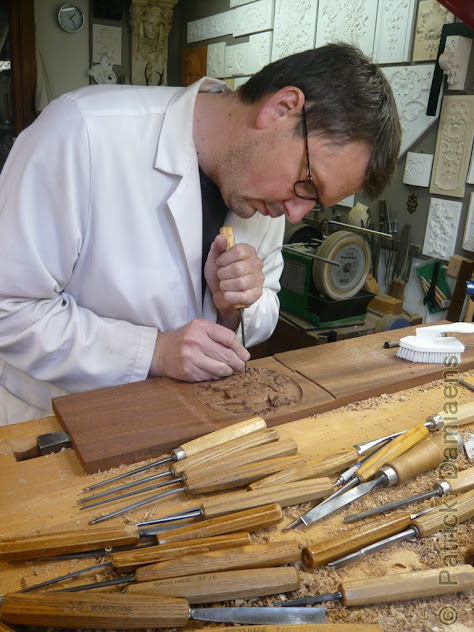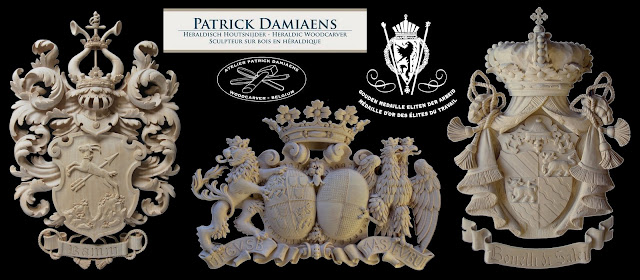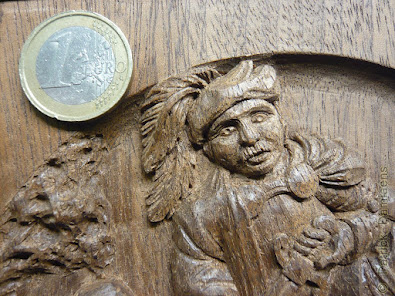 |
| Bas-Relief of Saint Martin of Tours Carved in Wood |
A Bas-Relief of Saint Martin of Tours Carved in Wood
A low-relief or bas-relief is a sculpting
method which is characterized by a rather shallow representation of the image. Usually
the image or subject has been flattened substantially. As a result it only
appears realistic when viewed from the front. The side view of a bas-relief
renders a significantly distorted image.
Method
First, a rough sketch is made. The origin or
source of the drawing can be based on an original panel, provided that any
inaccuracies or imperfections are modified. The design can also originate from
a personal expression, while of course staying true to the original “spirit” of
the design. The internet often serves as a great source of inspiration and
guidance.
Upon refinement, the final drawing is copied
onto tracing paper, which is then applied to the wood with thumbnails. By
making use of carbon paper and a scriber the drawing is transferred to the
wood. The image of the bas-relief is now present on the wooden panel.
 |
| Bas-relief carving | Bas-Relief in wood |
The wood
carver uses a router to remove any wood surrounding the image, thus creating a
work plane or work field.
The actual wood carving can now begin. This
phase is called “modelling”. Many years of training, diligence and fulltime
experience are of vital importance to master this technique.
The importance of the routing work now becomes
apparent. During the modelling phase the original drawing of the image
gradually disappears. During this step the drawing or pattern is reapplied to
the wooden panel by means of a scriber or marking tool.
 |
| Bas-relief carving | Bas-Relief in wood |
The lines and markings left by the marking
tool are now chiseled of. The contours or outline of the pattern slowly starts
to appear. In this phase the chisels act as drawing instruments. It is
important not to carve too deep, i.e. to the base (of the relief), so that it
is always possible to make (minor) changes to the relief.
The panel is now finished and can be returned
to the cabinet-maker (joiner), so it can be integrated into the wooden
mantelpiece.
 |
| Bas-Relief of Saint Martin of Tours Carved in Wood |
Saint Martin of Tours – A Brief History
Saint Martin is a well-known saint. Many
places and churches have been named in his honor. Maybe you know one or two?
Martin (Latin: Martinus), meaning “little Mars” (The Roman God of war) was born
in 316 AD. During that time emperor Constantine had just converted to Christianity.
Christians were therefore no longer persecuted. Saint Martin is generally regarded
as the first saint who did not die a martyr.
When Martin was 15 years old he joined the
army. He became a Roman legionnaire. He had to because his father was a regular
soldier in the Roman army too. At that time a son had to follow in his father’s
footsteps. However, Martin turned out to be quite an exceptional legionnaire.
He was different from the others. He was patient and modest, helped the sick,
and gave everything he didn’t need to the poor and needy.
One day something
truly remarkable happened. Something people still mention to this day. This
story is recounted in old books about the life of Saint Martin. At the time
these types of books were true bestsellers. They served as a source of inspiration
for countless stories, songs and plays. It was winter and it was freezing cold.
Many people had frozen to death, especially the poor.
Martin saw a beggar
sitting at the city gate. The man was cold as he was only wearing thin, ragged
clothes. Yet, everyone walked passed him, and offered only lame excuses. They
did not have any money, their purse was tucked away too far beneath their
clothes, or they were late for a meeting. It was bitterly cold and everyone was
in a hurry to get home. Martin was on his way home as well, and he too did not
have anything to offer, or did he?
He had no money. He
did, however, carry his sword with him, and he was wearing a warm army
overcoat. Suddenly, he did something unusual. He used his sword to cut his coat
in two, upon which he gave one part to the beggar. He reckoned a coat this size
could easily keep two people warm. He could have also simply given the whole
coat. However, as these overcoats were very expensive, the army agreed to pay half
of it. You can’t give away what is not yours to give! Saint Martin died in 398,
not in his monastery (just outside of Tours, France), but in Candes, a small place
in his bishopric. His grave is located in Tours.
 |
| A Bas-Relief of Saint Martin of Tours Carved in Wood Bas-relief carving |
This small
bas-relief was carved in mahogany wood. The relief has a depth of 8mm and the
panel will be integrated into a wooden mantelpiece,
alongside two other panels, that represent the coat of arms of the town of
Zaltbommel (NL); an old version of 1816 and a more recent rendition from 2001.
(The dimensions of this miniature carving are 12x8 cm)
The mantelpiece is
made out of pitch pine. These heraldic panels will be tastefully integrated
into this mantelpiece, after which it will painted in a
light color (probably off-white). Only the center panel with the bas-relief of
Saint Martin will retain its original mahogany wood color (apart from some
furniture wax), making it a real eye-catcher!
The customer, a Zaltbommel resident (NL),
choose this particular bas-relief because Saint Martin is the patron saint of
the Zaltbommel basilica (Dutch: Grote of St. Maartenskerk). This large basilica,
located in the center of Zaltbommel, has a three-aisled nave and a one-aisled
choir. Construction started around 1450 and the building was completed in 1500.
 |
| The City of Zaltbommel coat of arms in wood |
 |
| The City of Zaltbommel (NL) coat of arms in wood |
This miniature low-relief panel clearly
depicts Saint Martin of Tours, sword in hand, cutting of a piece of his coat to
give to the beggar. (I couldn’t resist to attach a purse to his belt.)
I also carved the coat of arms of Zaltbommel
on his shield.
(Dimensions: 15x15 cm; depth relief: 8mm)
Translation Koen Verhees
 |
| https://www.patrickdamiaens.info |
 |
| FB Page |





